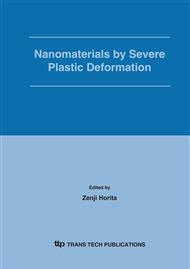p.25
p.31
p.37
p.45
p.51
p.57
p.65
p.71
p.77
On the Microstructure of HPT Processed Cu under Variation of Deformation Parameters
Abstract:
The evolution of strength characteristics and the microstructure of copper subjected to high pressure torsion (HPT) are studied under variation of strain and hydrostatic pressure. Measurements of Multiple X-ray Bragg Profile Analysis (MXPA) yield microstructural parameters like dislocation density and arrangement, as well as crystallite (domain) size and distribution, and long-range internal stresses. TEM investigations are carried out to analyse the structural elements and to compare them with the results of MXPA. The strength behaviour is studied by microhardness measurements. The investigations are performed within wide ranges of resolved shear strains = 1 to 400 and of applied pressures p = 0.8 to 8 GPa. The onset of the deformation stages IV and V is strongly affected by the hydrostatic pressure i.e. shifted to higher values of stress and strain with increasing pressure. The experimental results indicate the occurrence of recovery effects, which seem to be of static as well as of dynamic nature, and to be responsible for extended ductility in SPD materials.
Info:
Periodical:
Pages:
51-56
Citation:
Online since:
January 2006
Price:
Сopyright:
© 2006 Trans Tech Publications Ltd. All Rights Reserved
Share:
Citation:


